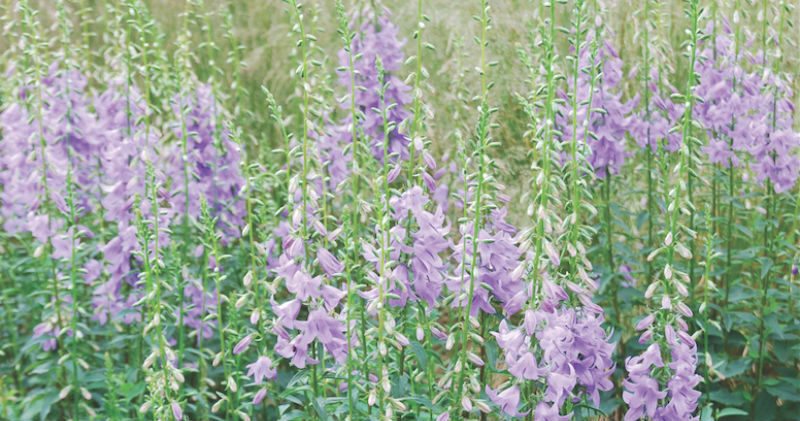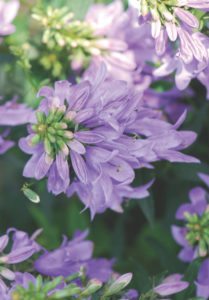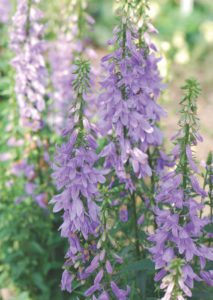
Perennial Solutions: Adenophora confusa ‘Fairy Bells Gaudi Violet’
It’s really great to witness all of the fine breeding efforts that have occurred with perennials over the past couple of decades. I particularly like to see when a breeder takes a little-known plant, such as Adenophora confusa, and selects characteristics that dramatically improve its marketability and landscape performance. ‘Fairy Bells Gaudi Violet’ is a great example of this.
There are numerous improvements over the straight species it was derived from. Gaudi Violet is more compact, growing just 18 to 24 inches tall compared to the larger 48+ inches growth habit of A. confusa. This cultivar produces significantly more flowers and reblooms very well, whereas the species is less floriferous and only reblooms sporadically.
Gaudi Violet has strong, healthy, green foliage and a tight clumping habit, reaching just 18 inches across at maturity. Its terminal racemes of soft violet drooping bell-shaped flowers results in an elegant upright form. The lightly fragrant flowers appear in the early summer and continue well into the fall, particularly when deadheaded. In fact, Gaudi Violet blooms long after most perennials have finished.

Adenophora is a member of the Campanulaceae family, which includes many popular types of campanula, lobelia and platycodon. Gaudi Violet can be grown in a wide range of soil types provided there is good drainage. It prefers locations with full sun but can be grown with various amounts of light exposure. Ladybells are very cold hardy and can survive winters to USDA Hardiness Zone 4.
With its upright and free-flowering habit, Gaudi Violet is sure to turn the heads of those you pass it by. This combined with its long season of bloom make it a very desirable landscape perennial. Ladybells can be used in borders, mass plantings or as cut flowers. Additionally, adenophora is a great perennial for attracting butterflies and hummingbirds into the garden while keeping critters such as deer away.
Propagation
Adenophora ‘Fairy Bells Gaudi Violet’ is vegetatively propagated from tip cuttings. It is patented; therefore, a license is required for propagation. Adenophora roots easily provided a few basic guidelines are followed.
Moisten the growing mix or stabilized growing media prior to sticking the unrooted cuttings. Rooting agents are optional as Gaudi Violet roots readily without these compounds. Place the cuttings under a moderate misting regiment for the first two to three days of propagation. After the first few days, decrease the amount of mist being delivered each day to light misting; misting can generally be removed altogether at 12 to 16 days after sticking. Rooting occurs best when they are propagated under high humidity levels (90 percent relative humidity) with minimal misting.
Fertilizers can be applied continuously with the mist water at 50- to 60-ppm nitrogen or every five to seven days applying 100- to 120-ppm nitrogen in the irrigation water. The cuttings are usually rooted and ready for transplanting in approximately five to seven days with soil temperatures ranging from 68 to 72° F.
Production
Adenophora ‘Fairy Bells Gaudi Violet’ is suitable for production in intermediately sized containers such as 1-gallon pots. They perform best when grown in a growing mix with both good water holding characteristics and adequate drainage; many peat- and bark-based growing mixes work well.
When transplanting, the liners should be planted so the original soil line of the liner is even with the surface of the growing medium of the new container. When growing in large container sizes, it is best to plant them in the late summer or early fall, bulk them up and overwinter them in the final containers. Otherwise, spring planting either vernalized or non-vernalized will also result in high-quality plants.
Ladybells have light to moderate fertility requirements. When using water-soluble fertilizers to deliver nutrients, apply 100- to 125-ppm nitrogen plus micronutrients with every irrigation or 250 ppm as needed. Fertilizing them too heavily will result in elongation and reduced flower power. Controlled-release fertilizers can also effectively deliver nutrients when incorporated into the growing medium prior to planting at a rate equivalent to 0.9 to 1.1 pounds of elemental nitrogen per cubic yard of growing mix or applied as a top-dress onto the media surface using the medium labeled rate. During production, maintain slightly acidic conditions; pH: 5.8 to 6.3.

and free-flowering habit.
Adenophora can be grown under average irrigation regiments. The plants should be kept slightly moist, but not saturated or consistently wet during production. They will grow taller and be more prone to root rot pathogens when too much irrigation is provided. When irrigation is necessary, water them thoroughly and then allow the soil to dry slightly between waterings.
Gaudi Violet has a sturdy upright growth habit and generally will not require height management strategies. However, when they are grown at high plant densities and with an ample supply of nutrients and moisture, some height control could become necessary. The most effective strategy
for reducing plant height is to provide adequate spacing between the plants. If growth control or toning is required, the plants can be sprayed with 2,500-ppm daminozide, 30-ppm paclobutrazol, 5-ppm uniconazole, or with my favorite PGR combination of 2,000-ppm daminozide + 3-ppm uniconazole. One to two spray applications should provide sufficient height control.
If the plants do become overgrown or are past their prime flowering appearance, they can be cut back and reflushed into full bloom six to eight weeks after trimming.
Insects and Diseases
Adenophora can generally be grown without many problems caused by pests or diseases. Growers and scouts should look for aphids, spider mites, western flower thrips and whiteflies. The primary diseases to watch for include Botrytis, Pythium and Rhizoctonia. Good cultural practices, including irrigation management, proper plant spacing and plenty of air circulation, greatly reduce the occurrence of most of these diseases. Routine scouting is useful and recommended to detect the presence of insect pests and plant diseases early, allowing the appropriate control strategies to be implemented before significant crop injury or mortality occurs.
Temperatures and Scheduling
Adenophora ‘Fairy Bells Gaudi Violet’ is typically scheduled to obtain flowering plants for mid-spring through early summer sales. They do not require vernalization for flowering. However as mentioned previously, it is best to bulk up and overwinter them when they are being grown in large container sizes. Otherwise, they can be grown under natural day lengths in the spring. The time to bloom depends largely on production temperatures. When spring planting and growing with 24-hour average temperatures of 65° F, it will take 12 to 14 weeks to produce flowering 1-gallon containers or 14 to 16 weeks for 2-gallon containers.
Availability
Adenophora ‘Fairy Bells Gaudi Violet’ is brought to the market by Plant Haven Inc. Unrooted cuttings are available from Dümmen Orange. Rooted liners can be obtained from Battlefield Farms and other reputable perennial propagators.


 Video Library
Video Library 




















